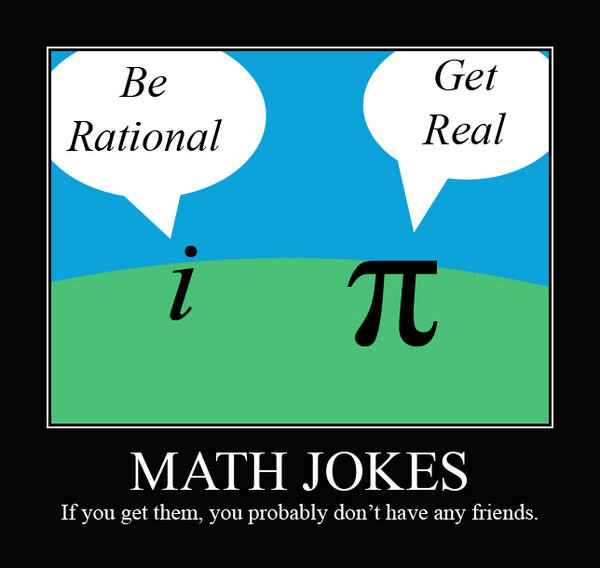This page is a permanent link to the reply below and its nested replies. See all post replies »
Pfuzylogic · M

helenS · 36-40, F
@Pfuzylogic Got it! "I ate some pie" 😋
DeWayfarer · 61-69, M
@helenS many pies! 😆. Too bad limits weren't shown though.
Pfuzylogic · M
ArishMell · 70-79, M
@helenS :-)
Actually it didn't take me long to remember the letter 'i', nor that the capital Greek letter (Sigma?) means "sum".
Two-cubed and pi of course are simple. I have never studied Series to any depth, and Imaginary Numbers not at all; but I recalled vaguely from work seeing that the square-root of minus one occurs in some electrical calculations.
'
Some years ago I was on holiday, on Crete. Near our accommodation was a big building with a string of maths and physics symbols along it.
Using the phrase-book I pieced it together and came up with "phyl.....". Phyl? Phyll?
AH! As in Chlorophyll and Phyllite (a type of fibrous rock)...
Plants! Yes, the building was a garden-centre!
Actually it didn't take me long to remember the letter 'i', nor that the capital Greek letter (Sigma?) means "sum".
Two-cubed and pi of course are simple. I have never studied Series to any depth, and Imaginary Numbers not at all; but I recalled vaguely from work seeing that the square-root of minus one occurs in some electrical calculations.
'
Some years ago I was on holiday, on Crete. Near our accommodation was a big building with a string of maths and physics symbols along it.
Using the phrase-book I pieced it together and came up with "phyl.....". Phyl? Phyll?
AH! As in Chlorophyll and Phyllite (a type of fibrous rock)...
Plants! Yes, the building was a garden-centre!
ArishMell · 70-79, M
@helenS Mmmm! Intriguing...
Discounting 0, I think the only two real integers whose sum equals their product, is 2 and 2, both positive. Powerful little number for its size, is 2...
But two that match a criterion like that 10 and 40? I suspect they are not alone in that construction though, (giving other sums and products).
Thinking of the factors of 40 from 1 to 10, adding and multiplying their combinations don't give both 10 and 40. So is one negative? If real numbers, I can see both are -ve for a +ve product... but beyond that...
Short of sliding spreadsheet columns of numbers past each other to see what happens - a luxury Cardano did not have - I don't know where to go with it!
Discounting 0, I think the only two real integers whose sum equals their product, is 2 and 2, both positive. Powerful little number for its size, is 2...
But two that match a criterion like that 10 and 40? I suspect they are not alone in that construction though, (giving other sums and products).
Thinking of the factors of 40 from 1 to 10, adding and multiplying their combinations don't give both 10 and 40. So is one negative? If real numbers, I can see both are -ve for a +ve product... but beyond that...
Short of sliding spreadsheet columns of numbers past each other to see what happens - a luxury Cardano did not have - I don't know where to go with it!
helenS · 36-40, F
@ArishMell Of course those numbers we are looking for can't be "normal" real numbers. The largest product of two numbers x and y with the sum of 10 is 25 (x=y=5).
Let sqrt(a) be the square root of a, then one solution to the problem is:
x = 5 + sqrt(-15)
y = 5 - sqrt(-15)
The sum ist ten, the product is 40 – check it out!
Cardano didn't know what to do with something like "5 + sqrt(-15)" – it made no sense to him. The interesting point to him was that the imaginary parts cancel out each other when we sum up both numbers and when we multiply them.
Fascinating.
Let sqrt(a) be the square root of a, then one solution to the problem is:
x = 5 + sqrt(-15)
y = 5 - sqrt(-15)
The sum ist ten, the product is 40 – check it out!
Cardano didn't know what to do with something like "5 + sqrt(-15)" – it made no sense to him. The interesting point to him was that the imaginary parts cancel out each other when we sum up both numbers and when we multiply them.
Fascinating.










